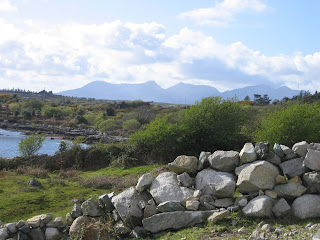Paula posts a few more photos of Ireland!
As you already know, I love Ireland - so here is a selection of photos from the hundreds I have taken during my many visits to this beautiful and fascinating island. Today I'm looking at some examples of Ireland's history.
First is a tomb portal, dating from the Neolithic period. It is known as Poulnabrone and is situated in the middle of the stark landscape of the Burren in County Clare. The horizontal capstone is supported at a height of about 6 feet by 4 upright stones, In the 1980s an excavation in the tomb under the portal revealed the bodies of 16 adults and 6 children, who were buried there sometime between 3,800 and 3,600 BC.
This is Croagh Patrick, overlooking Clew Bay in County Mayo. It is considered to be Ireland's holiest mountain because tradition has it that St Patrick fasted at the top for 40 days and nights in 441 AD. Today it is a place of pilgrimage, and some people even make the long climb to the top barefoot. On the last Sunday in July a special pilgrimage takes place with over 25,000 people taking part in the Mass at the summit.
Glendalough Monastery is one of Ireland's most famous ruined monasteries. Founded in the 7th century, it lies in a beautiful valley in the Wicklow Mountains, south of Dublin. Glendalough means 'valley of the two lakes.' The photo shows a familiar sight in Ireland - a round tower. This one is about 30 metres (90 feet) high, and originally had 6 timber floors, connected by ladders. Towers like this were used for storage, and also as a place of refuge in times of attack.
Moving closer to the present day, this is a reconstruction of one of the 'famine ships' which took thousands of Irish people across the Atlantic to the USA or Canada following the disastrous failure of the potato crop in 1845. These ships were often referred to as 'coffin ships' because they were so crowded and disease-ridden that many people died during the Atlantic crossing. This ship is moored at New Ross in County Wexford, and costumed performers take visitors on guided tours.
This monument, near Clifden in County Galway, commemorates a different form of transport, namely the first non-stop trans-Atlantic flight in 1919. Captain John Alcock and Lieutenant Arthur Whitten-Brown took 16 hours to fly from St. John's in Newfoundland to the west coast of Ireland - where they unceremoniously pitched their bi-plane nose first into an Irish bog!
And one final photo - of Connemara, my favourite part of Ireland!
All photos © Paula Martin
.jpg)






The tomb portal is amazing. How the mourners set those heavy stones in place is still a mystery, I bet. Like Stonehenge.
ReplyDeleteLove your photos, Paula!
The ancient people were amazingly ingenious!
DeleteGorgeous photos. Love them!
ReplyDeleteThanks, Jen :-)
DeleteA beautiful history lesson, Paula. Thanks for sharing.
ReplyDeleteJust a very small selection of some of the historical sites, Margaret. There are thousands more all over Ireland.
DeleteSomeday I WILL get to see Ireland in person...until then, as always, thanks for the beautiful pictures Paula.
ReplyDeleteYes, you must, Deb. Am sure you would love it!
DeleteWonderful photos. I don't know why the Irish Tourist Board don't employ you! You'd have thousands visiting.
ReplyDelete